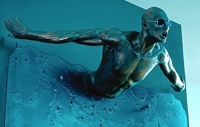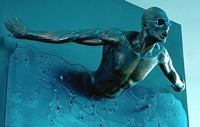Why we have a placebo effect – Part I
By Peter Blanch
For a long time now, I have stood with my feet precariously placed on two icebergs that sometimes slowly drift apart and sometimes drift back together again (obviously increasing and decreasing my sensation of precariousness). The first iceberg is where I started as a clinician, with both my feet solidly planted in the belief that all my patients got better from my superior diagnostic skills and almost magical treatment abilities. Later in my career, I made a rather silly step and tentatively lifted one of my feet and placed it on to the solid and friendly looking iceberg next to me, the one of clinical research. Almost immediately the gap between the two started to widen.
In 2001, I was reading an article in New Scientist (Watts 2001) (all of us cool/nerdy sciencey guys were) and it started, ‘Do you want to start a new therapy?,’ which of course heightened my interest as perhaps ‘Blanch therapy’ could be the new musculoskeletal cure-all. The article then went on to outline the placebo effect in, at the time, quite uncomfortable depth. Over time, I read more and more about this area and came to the conclusion that people get better, and they don’t always get better for the reasons we think they get better. That often we in musculoskeletal medicine often fall into the logical error known as “post hoc ergo propter hoc” or for those of you whose Latin is a little rusty, “after this, therefore because (or on account) of this” (Damer 2009). We have a theory, we treat a patient, the patient gets better, and therefore our theory is correct. This may seem a minor point as long as you think that the only responsibility you have is trying to get people better. However, our responsibilities, when placed in the privileged position of someone paying you to make them better then extend to asking: why do people get better?
For a while, this realisation had an epic global warming effect, with my two icebergs floating apart quite dramatically, to the point I felt like I was going to either split in two or fall off both into the cold water of uncertainty. I have come to accept that the relationship, rapport and empathy I develop with patients are extraordinarily important to the outcome of the treatment. My beliefs and their beliefs and what I can get them to believe will ultimately shape the therapeutic experience. This is not from any ‘hug a tree’ and ‘save a whale’ spirituality, but that is what the evidence shows us. I think that this is outlined extremely well in the books of Dylan Evans (Evans 2003) and Daniel Moerman (Moerman 2002). We are psycho-social biological beings and to believe therapeutic interventions only have a biological effect is ridiculous. This should not be interpreted as all our techniques and tools used in the treatment of patients are all due to the placebo effect. On the contrary, if you believe this and approach your treatments without belief, conviction and enthusiasm, it is likely you will get poor outcomes due to the nocebo response. We must accept that the psycho-social aspect of a therapeutic encounter can enhance, in fact create (placebo) or negate (nocebo) the biological effect.
Whilst this brought my feet back closer together, it raises a rather tantalising question and perhaps the point of this blog, ‘Why do we believe, why do we have the placebo effect?’ I think there has been a bit of work recently that gives us a strong evolutionary biological argument on the nature of why humans believe and it has something to do with our genes.
Lorimer thought this would be a good spot to end this post because he has been advised by those in the know (ie Heidi) that we are close to the maximum recommended length of a blog post. So, the rest of what I have to say in this diatribe will be in the next post. Stay tuned…..
On Blanchy –
 Peter Blanch is a Sports Physiotherapist who has worked at The Australian Institute of Sport for the past 20 years and has had clinical experience across a wide range of sports. Being an Australian Sports Physiotherapist (note the upper case S and P – Peter is no pretender….) means placing a ‘y’ after one’s surname, so he is widely known as Blanchy.
Peter Blanch is a Sports Physiotherapist who has worked at The Australian Institute of Sport for the past 20 years and has had clinical experience across a wide range of sports. Being an Australian Sports Physiotherapist (note the upper case S and P – Peter is no pretender….) means placing a ‘y’ after one’s surname, so he is widely known as Blanchy.
For 13 of Blanchy’s years at the AIS, he was the Physiotherapist for the Australian Swimming Team and went to three Olympics, four Commonwealth games and numerous other major international competitions. He was asked to step in for Ian Thorpe in Lucerne ’02, but found the water just a little bit chilly. Combined with his clinical work he has been involved in numerous research projects and has a Masters degree in the three-dimensional analysis of swimming.
Recently he has been appointed as the Clinical Research Manager across the areas of Department of Physical Therapies and Performance Research at the Australian Institute of Sport. This, aside from being a very long title, places him in the position to be involved in research projects across a wide range of disciplines and subjects. Many think Blanchy was the secret to Australia’s excellent performance on International Playing Fields. Clearly he has either been moonlighting in Germany (hence the incognito picture) or he hasn’t work with the Socceroo’s. Oh, and clearly, in BiM fashion, he didn’t write this bio.
References
 Watts, G. (2001). The power of nothing New Scientist (2292)
Watts, G. (2001). The power of nothing New Scientist (2292)
Damer, T. E. (2009). Attacking faulty reasoning : a practical guide to fallacy-free arguments. Australia ; Belmont, CA, Wadsworth/Cengage Laerning.
Evans, D. (2003). Placebo : the belief effect. London, HarperCollins.
Moerman, D. E. (2002). Meaning, medicine, and the “placebo effect”. Cambridge ; New York, Cambridge University Press.
Moerman DE, & Jonas WB (2002). Deconstructing the placebo effect and finding the meaning response. Annals of internal medicine, 136 (6), 471-6 PMID: 11900500
All blog posts should be attributed to their author, not to BodyInMind. That is, BodyInMind wants authors to say what they really think, not what they think BodyInMind thinks they should think. Think about that!



